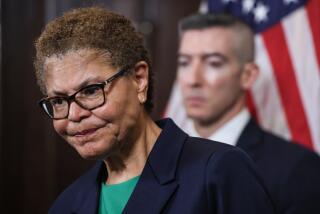Community College District Shortfall Cause for Concern : It must be asked why something wasn’t done sooner
- Share via
With the price of post-secondary education well into sticker-shock territory, any hint of trouble on the community college front is cause for serious concern. These institutions have long served a diverse population and their fiscal good health is in all our best interests.
Thus a midyear budget report indicating the Los Angeles Community College District has severely depleted its financial reserves after a five-year budget slide is giving us more than the midterm jitters. The nine-campus community college district, the nation’s largest, is projected to end the year with $5.6 million, less than 2% of its $282-million budget. Officials also predict that the district may for the first time violate state law requiring at least half of all expenditures to be for classroom instruction.
At individual campuses, the news may be even worse: Most, including Pierce College in Woodland Hills, are expected to end the year with actual deficits. The district projects this year’s shortfall at Pierce to be $1.4 million; last year it was $1.9 million. Pierce interim President Jack Fujimoto summed up the situation last week: “If we continue this type of ballgame,” he said, the district is “going to be bankrupt very soon.”
The budget report has triggered a state review to assess what can be done. Good. But we have to ask, why wasn’t something done sooner? These problems did not exactly sneak up on the district.
One of them, as reporter John Chandler has pointed out, is that several years of declining enrollment has led to reduced state funding. Further, there was an unexpected drop in tuition from foreign students when their ranks declined. Indeed, the district bleeds enrollment: There are 52,000 community college students living in the L.A. district who choose to study at campuses outside the district boundary. Yet only 12,000 living outside make the reverse commute.
Administrators acknowledge problems with course offerings: Some classes are probably obsolete. Others, such as ESL and basic English, are in great demand but relatively short supply. Waiting lists send students packing. Officials are trying this year to find solutions, but why wasn’t something done sooner? It’s not a new problem.
Meantime, the budget-wrecking list goes on: A costly faculty early-retirement plan offers potential savings in the long term but carries a high price tag now. And for the first time this year, the district will have to make a $1-million lease payment on its new downtown headquarters, all the while making debt payments--and facing the prospect of losing millions if it sells--on the mid-Wilshire high-rise it bought but never occupied.
Administrators have tended to blame the budget crunch on the economic downturn, the Northridge quake (three district campuses are in the Valley) and state funding cuts outside enrollment issues. But more than two years post-quake, with the economy improving and other districts coping with the same state cuts, this explanation is too simplistic. The money drain has to be stopped--now.
Keeping the community college system healthy is critical. Tuition at private colleges is sky high, and even state institutions have become less than affordable. For many, community colleges are the only option for post-secondary education. Standing by while they deteriorate and slip into bankruptcy is something we cannot afford.
Most campuses, including Pierce College in Woodland Hills, are expected to end the year with a deficit.
More to Read
Sign up for Essential California
The most important California stories and recommendations in your inbox every morning.
You may occasionally receive promotional content from the Los Angeles Times.













